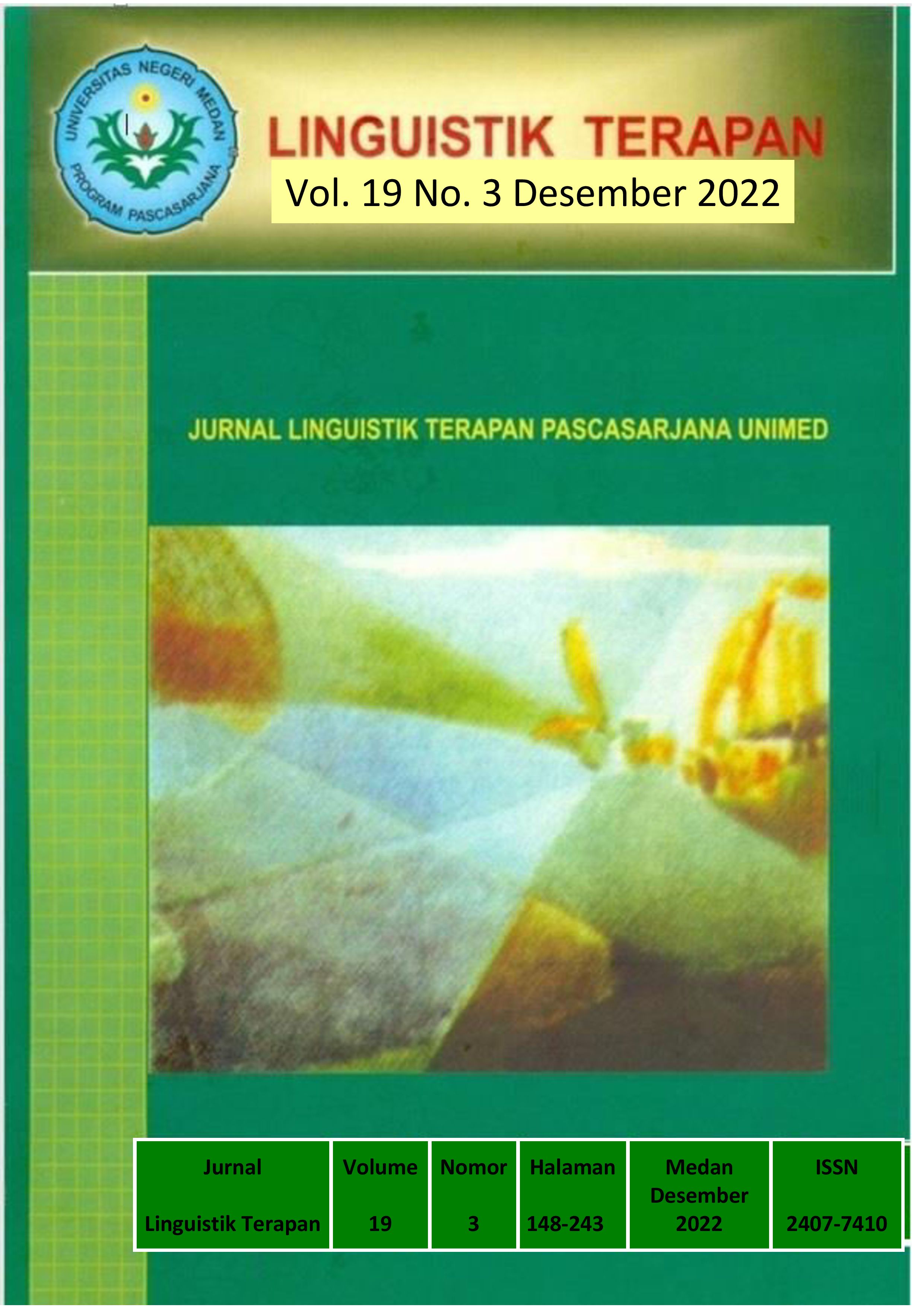PEDAGOGICAL TRANSLATION IN ENGLISH TEACHING USED BY TEACHERS IN TEACHER EDUCATION PROGRAM
DOI:
https://doi.org/10.24114/lt.v19i3.42052Keywords:
English Teaching, Pedagogical Translation, Teacher Education ProgramAbstract
The purposes of this research were to analyze what situations teachers use translation (from English into Bahasa Indonesia and vice versa) in the Teacher Education Program classes and to describe how the teachers implement the translation in classroom. The research utilized descriptive qualitative method. The participants of the research were two English teachers in high school level in Jambi Province. The data were collected in the form of video recording and then the utterances were transcribed and analyzed based on the theory of situation of using translation proposed by Atkinson (1987), which consists of six situations namely: Eliciting Language, Checking Comprehension, Giving Instruction, Presentation, Checking for Sense, and Language Testing/Language Assessment. The result showed that there were five situations of using translation occurred in this study, they are eliciting language, checking comprehension, giving instruction, presentation and language testing/assessment. Further, pedagogical translation is very useful to facilitate the communication process in the classrooms by interpreting the information received in one language (L1) into another language (FL) and vice versa.References
Akdeniz, Celal. (2016). Instructional Strategies. 10.1007/978-981-10-2519-8_2.
Al-Musawi, N. M. (2014). Strategic Use of Translation in Learning English as a Foreign Language (EFL) among Bahrain University Students. Comprehensive Psychology, 3. https://doi.org/10.2466/10.03.IT.3.4
Alrefaai, I. K. 2013. Suggested Guideline for Using Translation in Foreign Language Learning and Teaching. Educational Research, ISSN: 2141-5161, Vol 4.
Atkinson, D. (1987). The mother tongue in the classroom-a neglected resource?. ELT Journal 44 (4), 241-247.
Bhooth, Abdullah & Azman, Hazita & Ismail, Kemboja. (2014). The Role of the L1 as a Scaffolding Tool in the EFL Reading Classroom. Procedia - Social and Behavioral Sciences. 118. Pages 76“84. 10.1016/j.sbspro.2014.02.011.
Cook, G. (2010) Translation in Language Teaching. Oxford: Oxford University Press.
Day, R. & Park, J.-s. (2005). Developing Reading Comprehension Questions. Reading in a Foreign Language. 17. 60-73.
Giridharan, K., & Raju, R. (2016). Impact of Teaching Strategies: Demonstration and Lecture Strategies and Impact of Teacher Effect on Academic Achievement in Engineering Education. International Journal of Educational Sciences, 14, 174 - 186.
Gunawan, Sindy. (2020). Pedagogical Translation in Second Language Acquisition. Jurnal Basis. 7. 225. 10.33884/basisupb.v7i2.1996.
John Harbord, The use of the mother tongue in the classroom, ELT Journal, Volume 46, Issue 4, October 1992, Pages 350“355, https://doi.org/10.1093/elt/46.4.350
Jumal, Noor & AlSaqqaf, Asmaa & Nik Mmohamed, Nik. (2019). Code Switching in Malaysian Secondary ESL Classroom: A Preliminary Study from Sabah. International Journal of Asian Social Science. 9. 327-334. 10.18488/journal.1.2019.95.327.334.
Leonardi, Vanessa. (2010). The role of pedagogical translation in second language acquisition: From theory to practice. 10.3726/978-3-0351-0071-6.
LucÃa Pintado Gutiérrez (2021) Translation in language teaching, pedagogical translation, and code-Switching: restructuring the boundaries, The Language Learning Journal, 49:2, 219-239, DOI: 10.1080/09571736.2018.1534260
MahmutoÄŸlu, H. and Kicir, Z. 2013.The use of mother tongue in EFL classrooms. EUL Journal of Social Sciences, 4(1): 49-72
Mohamed, Tamer. (2014). Cohesion and Coherence Interrelation: An Approach to Literary Translation-Mahfouz's Trilogy. International Journal of Linguistics. 6. 209. 10.5296/ijl.v6i2.5549.
Newmark, P. (1988). A Textbook of Translation. New York: Prentice Hall.
Saricoban, A. (2012). Translation to Test Vocabulary and Language Skills. Procedia - Social and Behavioral Science, 46(2012), 2959 “ 2963. Retrieved May 19, 2018, from https://ac.elscdn.com/S1877042812017260/1-s2.0- S1877042812017260- main.pdf?_tid=9bfa443c-c00d-4d88-a30ff1f99f713f3b&acdnat=1526785213_ac892 c270f77d3e9669cab4c4c85feaf.
Schaffner, C., & Adab, B. (2000). Developing Translation Competence: Introduction. In Developing Translation Competence (pp. ix-xvi). Amsterdam: John Benjamins Publishing Company.
Schjoldager, Anne. (2017). Translation for Language Purpose: Preliminary Results of an Experimental Study of Translation and Picture Verbalization. HERMES-Journal of Language and Communication in Business. 16. 199. 10.7146/hjlcb.v16i30.25722.
Shiyab, S.M. (2006). A Textbook of Translation: Theoretical and Practical Implications.
Stephan Breidbach & Thanh Hang Tran (2022) The Routledge Handbook of Translation and Education, the Interpreter and Translator Trainer, 16:1, 135-139, DOI: 10.1080/1750399X.2021.1992849
Stern, H. H. (1992). Issues and Options in Language Teaching. Oxford: Oxford University
Press.
Widdowson, H. G. (2003) Defining Issues in English Language Teaching. Oxford: Oxford University Press.
Downloads
Published
How to Cite
Issue
Section
License
Copyright (c) 2023 Muhammad . Guntar, Dina . Sartika, Rina . Mulya, Rizky Femilya Elsa

This work is licensed under a Creative Commons Attribution-ShareAlike 4.0 International License.






